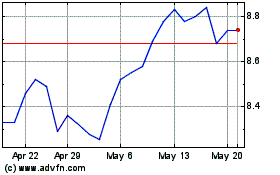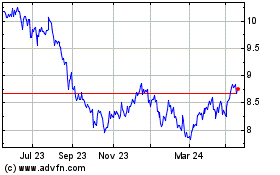AGL Shortlists Suppliers for A$250 Million Gas-Import Plant
June 03 2019 - 1:56AM
Dow Jones News
By Robb M. Stewart
MELBOURNE, Australia--AGL Energy Ltd. (AGL.AU) has drawn up a
short-list of potential suppliers of liquefied natural gas for an
import terminal it wants to build near Melbourne, ahead of a final
investment decision on the project early next year.
It comes as momentum builds for as many as five projects capable
of easing an energy crisis along Australia's east coast where
rising gas prices have prompted some manufacturers to threaten to
move production overseas. It has also added to the cost of living
for debt-laden households.
Phaedra Deckart, AGL's general manager for energy supply, said
talks to provide some of the liquefied natural gas that will be
processed through the 250 million Australian-dollar (US$173
million) project centered on an initial five-year contract
term.
The company also expects to purchase more over a mid- and
long-term basis and also buy fuel from spot markets as an expected
natural-gas shortfall grows in eastern Australia, she said.
"There's no reason it can't be U.S. LNG," Ms. Deckart said in an
interview with The Wall Street Journal. U.S. LNG meets Australian
standards for and meets the specification for lean gas, she
said.
U.S. companies are retooling existing facilities to meet rising
demand for LNG, while also building new plants. That is helping to
create a more liquid market for LNG--buyers not only have more
options when negotiating supply deals but more flexibility around
pricing structures and contract lengths.
If AGL clears a rigorous independent environmental review of its
project, the company could begin importing LNG in 2021. Gas would
then be connected via a new pipeline to its existing network, due
to a deal with pipeline operator APA Group (APA.AU). The company
has signed a contract with Norway's Hoegh LNG for a ship that will
be docked at Crib Point, where it will store LNG and, when needed,
warm it and pump natural gas ashore.
Depending on demand, AGL expects between 12 to 40 LNG ships a
year would moor alongside its facility, known as a floating storage
and regassification unit, at Crib Point. The company is looking to
select one of two FSRU facilities available from Hoegh that have
technology onboard capable of returning LNG back into a gas,
possibly using seawater to warm it.
"When we started talking about this two or three years ago, the
market thought we were crazy and no one thought it would ever
happen. Now we have five projects being talked about, it does give
support to the fact LNG imports are an necessary requirement to
meet needs on the east coast, " Ms. Deckart said.
AGL currently purchases natural gas from domestic producers to
supply its 1.4 million has customers, so import terminals must be
part of a broader solution. Management thinks more gas deposits in
Australia need to be developed as well.
The country's energy-market operator in March said gas shortages
were likely in eastern states and territories from 2024, driven by
declining reserves in Victoria state that had long accounted for
much of supply. Also, aging pipelines need upgrading to deliver
more gas when demand is high. Ms. Deckart said the shortfall could
come soon during periods of peak demand in Australia's winter.
Neil Beveridge, senior oil analyst at Sanford C. Bernstein in
Hong Kong, expected AGL and others to look to gas-export plants on
Australia's far western coast for supply first but that the U.S.
could have a role to play, too. U.S. exports have surged since
early 2016 and there are now three export facilities operating from
the U.S. mainland, with several more set to open over the next few
years.
Write to Robb M. Stewart at robb.stewart@wsj.com
(END) Dow Jones Newswires
June 03, 2019 01:41 ET (05:41 GMT)
Copyright (c) 2019 Dow Jones & Company, Inc.
APA (ASX:APA)
Historical Stock Chart
From Jan 2025 to Feb 2025

APA (ASX:APA)
Historical Stock Chart
From Feb 2024 to Feb 2025
